Glycyrrhiza, Licorice, Gan Cao 甘草Liquorice, Dulcis radix (‘Sweet root’)Gan Cao (“Sweet root”, TCM) Yastimadhu (Ayurveda) Athimathuram (Siddha) Shing Mnar ཤིང་མངར (Tibetan) Asl us Soos (Unani) |

|
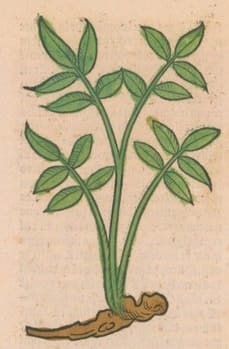 Ortus Sanitatis, Meydenbach, 1491
Ortus Sanitatis, Meydenbach, 1491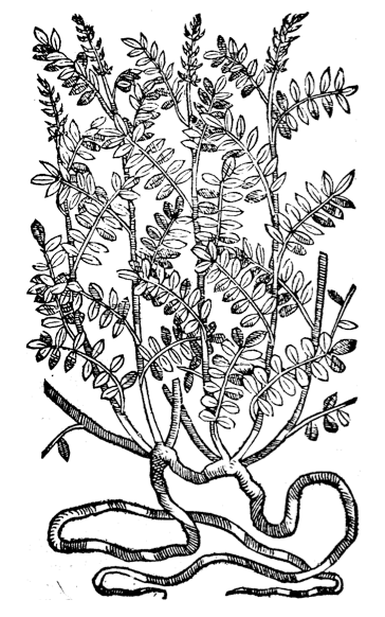 New Kreuterbuch, Matthiolus, 1563
New Kreuterbuch, Matthiolus, 1563
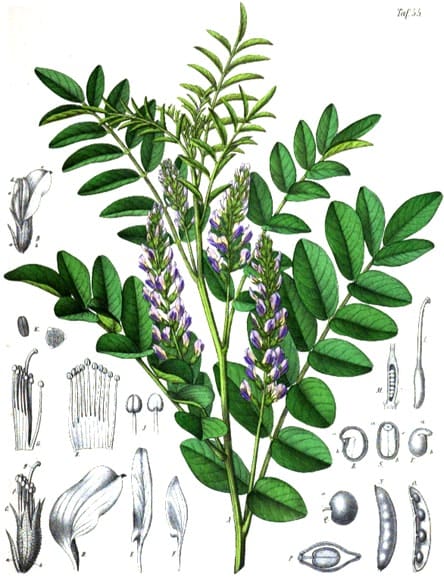 G. glabra
G. glabraAtlas der officinellen pflanzen (2), Felix, 1899 |
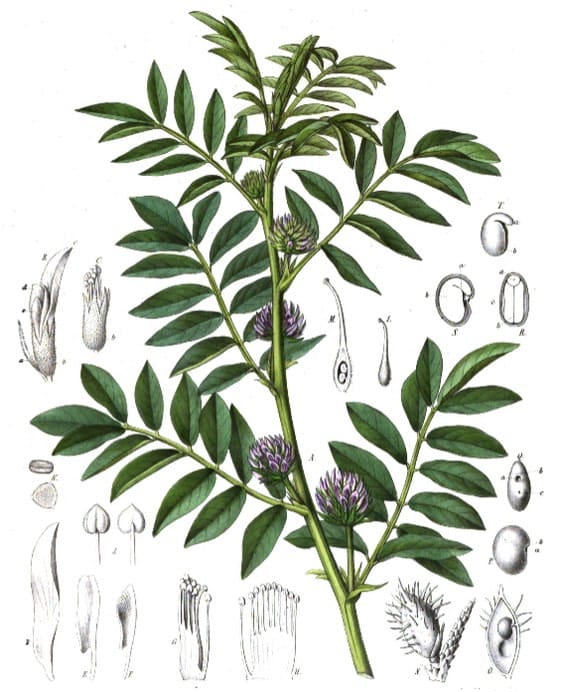 G. echinata
G. echinataDarstellung und Beschreibung sammtliche, Berg, 1858 |
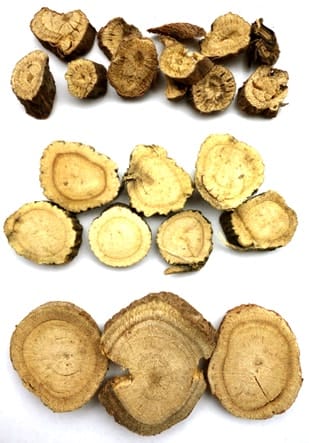 Three varieties of Licorice root available on the Chinese Market. The bottom is the highest quality being wild Licorice from XinJiang.
Three varieties of Licorice root available on the Chinese Market. The bottom is the highest quality being wild Licorice from XinJiang.
|
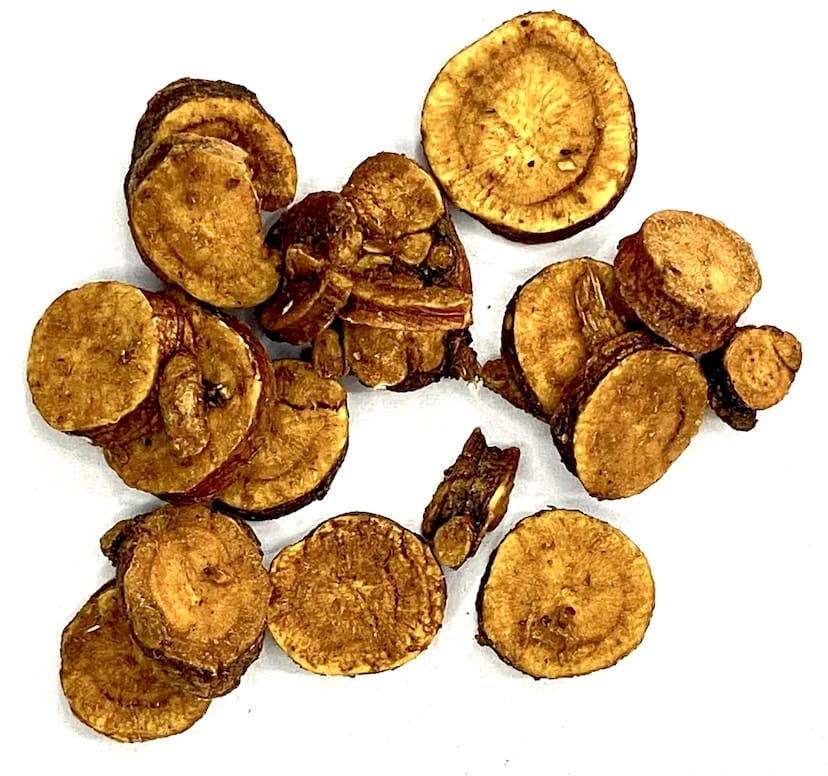 Honey Fried Licorice (Zhi Gan Cao) as used in Chinese Medicine.
Honey Fried Licorice (Zhi Gan Cao) as used in Chinese Medicine. |
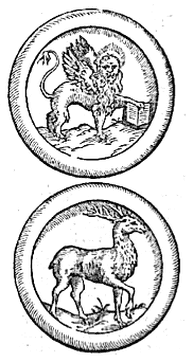
Licorice juice dried into round discs with a sealed image out of Gerard’s Herbal. |
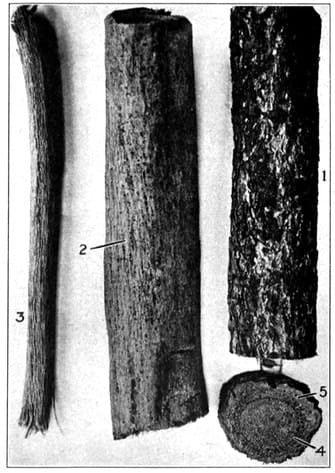
|
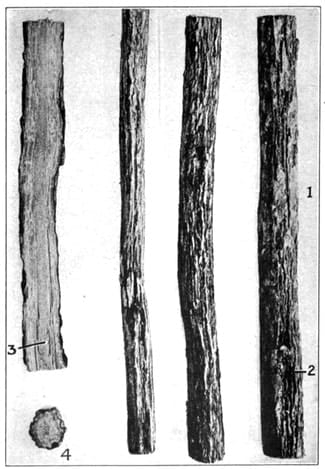
|
|
RUSSIAN LICORICE ROOT 1, Unpeeled root with gray and reddish-brown patches of cork. 2. Peeled root with small fissures. 3. Small peeled root. 4. Wood. 5. Thick cortex. |
SPANISH LICORICE ROOT 1. Rhizome showing wrinkled surface. 2. Small bud. 3, Longitudinal section showing central pith and cortex. 4. Cross-section of rhizome. |
Botanical name:
Glycyrrhiza spp.
There are around 20 species of Glycyrrhiza, a number of species have been used as a source of ‘Licorice’:
1. G. glabra; regular ‘Licorice’, native to Eurasia
2. G. echinata (syn. G. inermis, G. macedonica), German, Roman, Hungarian, East European or Chinese Licorice.
3. G. glabra var. glanulifera, Russian Licorice
TCM uses G. uralensis, G. inflata (‘Chinese Licorice’). G. yunnanensis (‘Yunnan Licorice’) as well as G. glabra and others.
There is sufficient crossover of the above-named species to say they are synonymous in use, although some will be stronger than others.
Parts used:
Root; dehydrated Juice
Temperature & Taste:
Warm, moist. Sweet
“The root of Licorice is moderate in temperament with an inclination towards hotness and moistness”. (Avicenna)
Classifications:
2I. ANTISPASMODIC. 2L. EMOLLIENT. 2S. STRENGTHENING.
3B. FEBRIFUGE & ANTIPYRETIC. 3E. DIURETIC. 3H. LACTAGOGUE. 3L. ANTI-TUSSIVE. 3O. EMETICS
4d. PECTORAL. 4e. STOMACHIC. 4g. HEPATIC. 4h. NEPHRITIC. 4j. NERVINE
Uses:
1. Strengthens the Lungs, Clears Phlegm, Stops Cough: (TCM, West, Ayurveda)
-dry Cough, Wheezing, Asthma, shortness of Breath, Bronchitis, Pleurisy; especially good for chronic Bronchitis
-Hemoptysis, Pulmonary Tuberculosis
-supportive in Lung Cancer, Emphysema
-Good for these conditions from Lung heat, dryness, or Lung deficiency, with or without Phlegm
2. Clears Heat and Poison, Benefits the Throat: (TCM, West)
-hoarseness, itching, soreness or irritation of the Throat
-a piece of root or the juice can be sucked
3. Clears Heat and Poison: (TCM, West)
-‘It takes away inflammations’. (Gerard)
-Sores, Boils, Eczema, Dermatitis, Impetigo, and other skin inflammations
–wide variety of skin conditions, acting similarly to hydro-cortisone.
-‘useful in chronic Fever’ (Avicenna)
-useful in various Allergies and Viral diseases.
-Scorpion Stings. (Ayurveda, Unani)
-Food Poisoning
-Fetal Toxicosis (Li Shi Zhen)
-‘Neutralizes the toxins of a hundred drugs … It harmonizes 72 stones and 1,200 herbs’ (Ming Yi Bie Lu)
4. Clears Heat, Quenches Thirst: (TCM, West)
-quenches Thirst for which it has been used since Dioscorides
-Thirst from various causes
-“Licorice quenches the Thirst due to its moist nature”. (Avicenna)
5. Tonifies the Spleen and Qi, Benefits Digestion: (TCM, West)
-weakness, fatigue and poor appetite associated with digestive weakness
-Peptic ulcers, gastritis, hyperacidity with pain; accepted for Gastro-duodenal Ulcers by Commission E.
-Colitis and Diverticulitis etc.
–Rasayana: tonic to the 7 Tissues; gives Strength, promote Complexion and Hair Growth, benefits the Voice and Eyes, and increases Semen
-also as an adjunct in Anemia
-“
6. Strengthen the Kidneys: (TCM, West, Ayurveda)
-Aphrodisiac; increases Semen, good for Sexual Debility (West, Ayurveda)
-Diabetes
-helps promote Ovulation
-useful to help prepare for Birth
–Adreno-corticol insufficiency
-adjunct in chronic Joint diseases
-Kidney and Bladder Ulcers
-‘stabilizes tendons and bones’ (Shen Nong Ben Cao)
7. Calms and Benefits the Liver (TCM, West):
-muscular spasm, pain and tension
-Liver congestion, Biliousness
–Hepatitis, Cirrhosis, Jaundice and other chronic Liver disorders
-Hypertension
–Hildegard said it ‘extinguishes Anger and Aggression’ and ‘Calms the Mind and Senses’
-‘facilitates the normal flow of the blood and Qi’. (Ming Yi Bie Lu)
8. Benefits the Heart Qi (TCM, Ayurveda, West):
–weakness or deficiency of the energy or blood with irregular pulse and/or palpitations
-breathlessness associated with Heart weakness
-‘Long-term intake of the drug enables the person to feel happy and enjoy a long life‘ (Shen Nong Ben Cao)
-‘pacifies the Mind and Soul’. (Da Ming)
-‘palpitations, restlessness, amnesia’. (Da Ming)
9. Promotes Milk:
-adjunct to promote Lactation (Ayurveda)
10. Emetic:
-in Panchakarma of Ayurveda (cleansing therapies), large doses of Licorice decoction are used as an emetic.
11. Harmonises, Moderates and Guides Medicines, Moderates Poison:
-softens bitter or strong-tasting medicines, making them more acceptable to the Stomach
-‘It is likewise joined with other Medicines, as well to moderate their Force, as to render them more agreeable. (A Treatise on Foreign Drugs, Geoffroy and Thicknesse, 1749)
-in TCM to moderate the effect of violent, harsh or toxic herbs (some cathartics being the main exceptions)
-specifically moderates Aconite and Arisaema species; also Datura, Coffee, Tobacco, Cocaine and Nux Vomica.
–Salmon said ‘it makes purging Physick work without pain’.
-balances and guides a formula; ensures medicines are led to their relevant areas, organs, and channels of the body.
-good to use with excessively hot or cold medicines to moderate them.
-added to complex formulas, where hot and cold medicines, or medicines of a different nature are combined together.
12. Externally:
-root is chewed to cleanse the mouth and teeth, and resist decay.
-dehydrated juice is dissolved under the tongue to quench thirst.
-root is sucked to alleviate the cravings for Tobacco.
-topically for Eczema, Psoriasis and Herpes
-decoction was used as a wash for Erysipelas (Ayurveda)
-wash or eye drops is used for Conjunctivitis, Blepharitis and other inflammations of the eyes
-in hair oils to promote hair growth and for greying hair
Dose:
1. The unprepared medicine is best for clearing Heat and Toxin.
2. The stir-fried root is warmer and more tonifying.
3. The Honey/Sugar-prepared root nourishes and strengthens.
4. The dried juice is best for the throat, coughs and to quench thirst.
Powder: 500mg–3 grams (typically 1–2 grams);
Decoction: 2–9 grams (typically 3–6 grams);
Fluid Extract (1:1): 2–4mls.
The dried juice can be taken in doses of 250mg–1 gram, or can be sucked as needed.
Preparation:
1. Honey-prepared Licorice: (Zhi Gan Cao)
Licorice root can be stir-fried in Honey or Sugar syrup. This makes the root more tonifying as well as helping to soothe the Lungs and stop Cough.
2. Stir-fried Licorice: (Chao Gan Cao)
The root is stir-fried until yellowish-red on the inside. This is more warming, and better for Cold Phlegm and Damp conditions and considered better for tonifying. (Li Shi Zhen)
3. Butter/Ghee-prepared Licorice: (Su Gan Cao)
An old Chinese preparation involved stir-frying Licorice root with about one-third of its weight of butter until the butter is consumed. This is more nourishing and tonifying.
Based on the Ayurvedic use of butter in such situations, it would be better to use Ghee (clarified butter).
4. Bile-prepared Licorice: (Dan Gan Cao)
Licorice root has been soaked in Bile to relieve Heat and stop Cough, especially in Children. It is soaked in bile, stir-fried until dry, then powdered. This is rarely used today. (TCM)
Substitute:
1. Mastic and Licorice share similar functions of strengthening the Spleen, increasing Qi, and harmonising medicines.
2. Licorice root or Licorice root extract can generally replace Licorice juice.
Comment:
Two other medicines derived from Licorice are in common use:
1. Licorice juice: Licorice juice is the black, shiny, brittle, sweet dehydrated juice of Licorice. It is sweet, slightly Bitter, and has the general function of Licorice root. However, it excels in the treatment of Lung conditions for which it was most used.
2. Stir-Fried Licorice (Zhi Gan Cao): this is Licorice root that has been stir-fried with Honey (traditionally) or Sugar syrup (more common today) until candied. It is sweet and sticky, and is used in decoctions in TCM. It is most used in Tonic formulas as it makes Licorice stronger to Tonify.
Correction:
1. Tragacanth (or Cochlospermum religiosum) for Kidney diseases (Unani)
2. Rose (Spleen diseases) (Unani)
3. In Ayurveda the precautions for Licorice (mainly edema, hypertension and osteoporosis) are nullified if it is decocted in Milk.
Main Combinations:
Almond & Licorice
Anise & Licorice
Cinnamon & Licorice
Coltsfoot & Licorice
Elecampane & Licorice
Licorice & Comfrey
Peony & Licorice
Raisin & Licorice
Rose, Sandalwood & Licorice
Lungs
1. Cough, Bronchitis, Lung diseases:
i. Syrup of Licorice alone is effective (Herbarium Horstianum, 1630)
ii. Wind-Cold or Spasmodic in Children, decoct Licorice with Aniseed
iii. Licorice, Poippy seed, Mastic
iv. Licorice with Barley, Raisin
v. Licorice with Maidenhair and Figs
vi. Licorice (2 oz.) with Hyssop (1 oz.) and Maidenhair (0.5 oz.); for Cough, Bronchitis, Lung ulcers, Pleurisy
vii. Licorice with Mallow seed, Pumpkin seed, Gum Arabic, Tragacanth, Saffron (as in Pills of Surfa of Unani)
viii. Cough, Hoarseness, loss of Voice, Asthma, spitting of Blood, Licorice with Tragacanth, Sweet Almonds (as in Black Troches)
viiii. Lung congestion, Licorice Basil, Long Pepper, Belleric Myrobalan, Chebulic Myrobalan, Tylophora, Sida (Ayurveda)
x. Cough with Chest Pain, Licorice juice, Dates stones (3 drams each), Starch, Saffron (1 dram each), Tragacanth (2½ drams). Beat and form pills the side of Chickpeas. Take one pill and hold under the tongue. (Syrian “Book of Medicine“, trans. by Wallis Budge, 1913)
2. Acute Sore Throat:
i. decoct Licorice with Burdock seed (TCM)
ii. decoct Licorice with Platycodon Jie Geng and Donkey Hide Gelatin E Jiao. (Ben Cao Gang Mu)
3. Influenza with Cough and Lung congestion, Licorice with fresh Ginger and Ephedra
4. Asthma, Chronic Cough:
i. Licorice, Coltsfoot, Bitter Almond, Maidenhair
ii. Licorice, Elecampane, Raisins, Coltsfoot
iii. Licorice taken with Lohoch of Pine nuts (Herbarium Horstianum, 1630)
5. To strengthen the Lungs:
i. Licorice, Elecampane, Mastic, Cinnamon, Saffron
ii. Licorice, Elecampane, Raisins, Sweet Almonds, Coltsfoot as a decoction
iii. Licorice with Sweet Almond, Pine nut, Hyssop, Maidenhair, Orris, Elecampane with Honey as an Electuary.
6. Consumption, Phthisis:
i. Licorice with Elecampane, and Flowers of Sulphur
ii. Licorice with Comfrey root and Asparagus root
iii. Licorice, Tragacanth, Poppy seed
iv. Licorice, Veronica, Barley, Aniseed (Herbarium Horstianum, 1630)
v. Licorice taken with Sound and Experienced Electuary (Lohoch Sanum et Expertum) (Herbarium Horstianum, 1630)
Digestion, Tonic
7. Licorice is combined with Rose in a number of formulas to strengthen and harmonise the Stomach and Spleen.
8. Stomach Pain: ‘let him take Licorice root in water without food and he will recover’ (Assyrian text)
9. Gastro-duodenal Ulcers and Inflammation:
i. Licorice, Rose, Sandalwood, Mastic
ii. Licorice with Fennel, Asparagus root, Emblic Myrobalan, Picrorhiza (Ayurveda)
10. Belching, Bloating, Fullness after eating:
i. Licorice with Fennel seed, Aniseed, Coriander, Cinnamon, Galangal
ii. Licorice with Caraway, Aniseed, Coriander, Ginger, Clove
11. Strengthen the Spleen and increase Qi:
i. Licorice with Atractylodes Bai Zhu, Codonopsis Dang Shen, Poria Fu Ling (as in Si Jun Zi Tang)
ii. Licorice with Elecampane, Fennel seed, Ginger
iii. Licorice with Withania, Sida cordifolia, Asparagus root (Ayurveda)
12. To promote Longevity, Virility and Intellect, and cure diseases of aging, combine Licorice with Tabasheer, Rock Salt, Long Pepper, Triphala (Ayurveda)
13. To promote Intelligence and as a Aphrodisiac, take 10 grams of Licorice powder with Milk and Honey (Ayurveda)
14. Anemia:
i. take Licorice with Honey (Ayurveda)
ii. Licorice, Date, Almond, Cinnamon
iii. Licorice with Dang Gui, Astragalus (TCM)
Spasms:
15. Muscular pain, spasm and tension, cramps:
i. Licorice with Peony (this is a stand alone formula for this purpose in TCM)
ii. Licorice, Valerian, Peony
Heart:
16. Heart tonic:
i. Licorice with Cinnamon (TCM)
ii. Licorice, Cinnamon, Mastic, Saffron
iii. Licorice with Picrorhiza (Ayurveda, Charaka)
17. Palpitations:
i. with slow, uneven pulse, decoct Licorice alone and drink daily (Ben Cao Gang Mu)
ii. from Cold and Yang deficiency Licorice with Cinnamon (TCM)
Poisoning:
18. Poisoning from drugs: soak Licorice root in Sesame oil, the longer the better. Let the patient chew the drug and swallow the saliva (Ben Cao Gang Mu)
19. Acute Food Poisoning and other acute Poisoning, decoct Licorice 10 grams with Green Mung beans 30 grams for 10 minutes; drink the Soup. (Chinese Kitchen remedy)
Other:
20. Thirst:
i. Liorice root or juice held in the mouth
ii. Licorice decocted in Barley water (Herbarium Horstianum, 1630)
iii. Licorice, Tragacanth, form troches to hold in the mouth
21. Edema:
i. combine Licorice with Sesame seed (Ayurveda)
ii. from Cold and Damp, Licorice, Celery seed, Parsley seed, Fennel seed, Ginger, Cinnamon
22. Emollient for Stones, Licorice decocted in Barley water with Raisins (Herbarium Horstianum, 1630)
23. Liver diseases:
i. Licorice with Madder, Long Pepper, Tinospora (Ayurveda)
ii. Licorice with Scutellaria Huang Qin, Paeonia Bai Shao (TCM)
iii. Licorice with Agrimony, Gentian, Fennel seed
24. Bleeding, vomiting Blood from Heat, Licorice with White Sandalwood, with Milk (Ayurveda, Chakradatta)
25. To prepare for Birth:
i. take equal parts of Cinnamon and Licorice daily for 2 weeks before the due date. (Culpeper)
ii. Licorice and Raspberry leaf tea, taken for 2 weeks before the due date
26. To promote Milk in nursing mothers:
i. take Licorice powder with Milk (Ayurveda)
ii. Licorice, Fennel, Aniseed
External:
27. Baldness or Alopecia, make a paste of Licorice powder with Saffron in Milk. Apply topically every night. (Ayurveda)
28. Licorice is used with Eclipta in hair oils to promote Hair growth, and for premature greying Hair. (Ayurveda)
29. Wounds, Bruises, Burns, Licorice powder is mixed with Ghee and applied
30, As an eyewash, Licorice with Triphala
Major Formulas
1. White Pectoral Troches:
i. Licorice root powder (1 oz.), Orris root powder (½ oz.), Sugar Candy (1 lb.), Mucilage of Tragacanth (sufficient). Make Troches.
ii. Licorice root powder (3 drams), Orris root powder (6 drams), Starch (½ oz.), White Sugar (8 oz.), mucilage of Tragacanth (sufficient) (Pharmacopoeia Suecica, 1817)
iii. Licorice root powder (1 ½ oz.), Orris root powder, Gum Arabic (½ oz. each), powdered White Sugar (48 oz.), mucilage of Tragacanth (sufficient). (Pharmacopoeia Generalis, 1783)
2. Black Pectoral Troches:
i. Licorice juice, Gum Arabic (equal parts). dissolve each separately in water, mix the liquors and evaporate to the proper consistency.
ii. Extract of Licorice, Gum Arabic (1 part each), Sugar (2 parts), Water (sufficient). evaporate the strained solution. (Edinborough)
3. Compound Licorice Troches:
i. Orris root, Licorice root, Aniseed, Fennel seed (1 oz. each), Licorice juice dissolved in Hyssop water (4 oz.), White Sugar (16 oz.), mucilage of Tragacanth (sufficient). (Dispensatorium Pharmaceuticum, 1777)
4. White Licorice Sticks:
i. Gum Arabic, Diambra, Diatragacanth (½ oz. each), Licorice powder, Starch (1 lb. each), White Sugar (2 lbs.), mucilage of Tragacanth (sufficient). Form sticks. (Pharmacopoeia Generalis, 1783)
5. Yellow Pectoral Troches:
i. Licorice root, Florentine Orris (1 oz. each), Saffron (2 scruples), White Sugar (1 lb.), mucilage of Tragacanth (sufficient). Make Troches, (Pharmacopoeia Generalis, 1783)
ii. Licorice (8 oz.), Diatragacanth, Florentine Orris (1 ½ oz. each), Saffron (8 scruples), Sugar (6 pounds), mucilage of Tragacanth (sufficient).
Cautions:
1. Not used in Phlegm conditions (without correction)
2. Full doses are not generally used on an extended basis; smaller doses as in powders is better for long-term use.
3. Edema, osteoporosis, and hypertension may be caused or aggravated by long-term use or large doses.
4. Incompatible with Euphoriba and Daphne species. (TCM)
Drug Interactions:
1. Can increase potassium loss when used with potassium-depleting drugs (diuretics)
2. Can cause increased sensitivity to cardiac medication (due to potassium loss)
3. Increases clearance time of corticosteroids, so care on people using steroids, especially prednisolone.
4. Can potentially counteract contraceptive pill.
5. Counteracts negative effects of NSAID’s on gastric mucosa (ie. inhibits irritations and ulceration)
Toxicity
No adverse effects were noted in single doses of up to 5000mg/kg of a standardized extract given to rats. Subchronic toxicity studies of 90 days revealed no adverse reactions at up to 1000mg/kg per day. (see here)
–Toxicological Effects of Glycyrrhiza glabra (Licorice): A Review.
Main Preparations used:
Licorice Juice, Syrup, Black Troches
1. Licorice Juice:
i. prepared by exhausting the root with several decoctions, combining the decoctions and inspissating until thick.
ii. Licorice powder 4 oz., Tragacanth dissolved in Hyssop water 6 oz. Infuse 24 hours, strain and dry in the sun until it grows hard and roll into cakes. (Natura exenterata, Philiatros, 1655)
2. Purified Licorice Juice:
i. dissolve in hot water, strain, evaporate to a firm mass and roll into cylinders on an oiled marble slab. Dry with gentle heat, then cut into sticks. (Pharmacopee Usuelle, Louvain, 1821)
3. Licorice juice with Gum:
i. Gum Arabic, Licorice juice (equal parts). Dissolve each separately in water, strain, mix and evaporate to a firm mass. (Pharmacopee Usuelle, Louvain, 1821)
4. Anisated Licorice juice:
i. Depurated Licorice juice while still warm (48 oz.), Anise oil (3 drams); mix, and roll into thin sticks and dry. (Pharmacopee Usuelle, Louvain, 1821)
5. Honey of Licorice:
i. Licorice root (8 oz.), Boiling Water (3 pounds); macerate 1 hour, express, evaporate to 14 oz., and add Honey (5 lbs.). Boil to a syrup. (Pharmacopoeia regni Poloniae, 1817)
6. Syrup of Licorice:
i. Licorice root (1 part), Water (3 parts), infuse an hour in a water-bath, strain, press, and dissolve in the infusion when cold White Sugar (2 parts)
7. Licorice Extract:
i. Licorice root (1 pound), Boiling Water (1 gallon). Macerate 24 hours, boil to 4 pints. Strain while hot and evaporate to an extract. (London)
ii. some decocted the residue again with fresh water, combined the decoctions, then evaporated.
8. Licorice Paste:
i. Grated Licorice (4 oz.), Boiling Water (8 oz.). Macerate 12 hours, strain, then dissolve in Gum Arabic (2 ½ lbs.), White Sugar (1 ½ pounds). Strain, and evaporate slowly until a drop thrown onto a cold glass plate gelatinises. Then pour the mass into oiled metallic molds, dry, then cut. (Pharmacopoeia Oldenburgica, 1801)
ii. Licorice (4 oz.), Water (32 oz.), boil to 24 oz., and dissolve in the strained liquor Gum Arabic (2 lbs.), White Sugar (1 ½ lbs.). Boil to a proper consistency. (Dispensatorium Pharmaceuticum, 1777)
9. Licorice Lozenges:
i. Licorice extract (1 part), Sugar, liquified over the fire (16 parts); pulverise the extract and mix into the sugar and roll the lozenges in starch. (Pharmacopee Usuelle, Louvain, 1821)
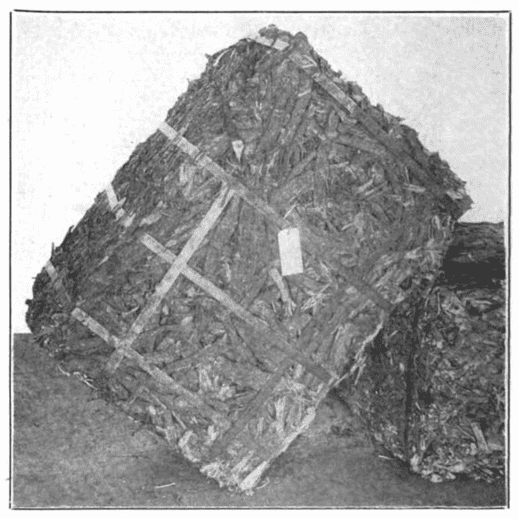 Packages of imported Licorice root from Persia.
Packages of imported Licorice root from Persia.A Manual of Organic Materia Medica and Pharmacognosy, Sayre, 1907
-
Extra Info
-
History
-
Research
-
Licorice Juice
|
‘Liquorice grows wild in Arabia, Persia, Turkistan and Afghanistan, and has been introduced in to the Punjab and Sind. Kinneir observed it growing abundantly near Basra, and Aitchison found it growing abundantly all over the Badghis and throughout the Harirud and Khorasan districts. In Persia glass-bottle-makers use the wood for melting their materials, as they say it gives a greater heat than any other kind of fuel. The root, in Sanskrit called Yashtimadhu and Madhuka, must have been known to the Hindus from a very early date, as it is mentioned by Susruta. Hindu works describe it as demulcent, cooling and useful in cough, hoarseness, &c. It is also recommended as a flavouring agent, and enters into the composition of many external cooling applications. Abu Hanifeh describes Sus as a well-known plant, the expressed juice of which is an ingredient in medicine. He says the roots are sweet and the branches bitter. El Mutarrizi in the Mughrib states that the leaves are put into the beverage called nabid to make it strong. The modern Arabs call the root Irk-es-sus, and make a |
strong infusion of it which they drink. The dried juice is called Rab-es-sus; it is made by the Arabs, Turkomans, and Persians at Yezd. In Persia the liquorice plant is called Mehak and Mazhu. The author of the Makhzan-el-Adwiya gives a lengthy description of the plant, and directs the root to be decorticated before it is used. He says that the Egyptian is the best, next that of Irak, and then Syrian. The root is considered hot, dry and suppurative, demulcent and lenitive, relieving thirst and cough, and removing unhealthy humours, also diuretic and emmenagogue, useful in asthma and irritable conditions of the bronchial passages. Ibn Sina recommends the decoction in cold colic; it is also dropped into the eyes to strengthen the sight. A poultice made of the leaves is said to be a cure for scald head, and stinking of the feet or armpits. Muhammad bin Ahmad and Yohanna bin Serapion recommend the seeds as being the most active part of the plant’. |
From Pharmacographia, Fluckiger & Hanbury, 1879
1. Licorice root
|
‘Theophrastus a in commenting on the taste of different roots (3rd cent. B.C.) instances the sweet Scythian root which grows in the neighbourhood of the lake Maeotis (Sea of Azov), and is good for asthma, dry cough and all pectoral diseases,— an allusion unquestionably to liquorice. Dioscorides, who calls the plant [?] notices its glutinous leaves and purplish flowers, but as he describes the pods to be in balls resembling those of the plane, and the roots to be sub-austere as well as sweet, it is possible he had in view Glycyrrhiza echinata L. as well as G. glabra. Roman writers, as Celsus and Scribonius Largus, mention liquorice as Radix dulcis. Pliny, who describes it as a native of Cilicia and Pontus, makes no allusion to it growing in Italy. The cultivation of liquorice in Europe does not date from a very remote period, as we conclude from the absence of the name in early mediaeval lists of plants. It is, for instance, not enumerated among the plants which Charlemagne ordered (a.d. 812) to be introduced from Italy into Central Europe; nor among the herbs of the convent gardens as described by Walafridus Strabus, abbot of Reichenau, lake of Constance, in the 9th century; nor yet in the copious |
list of herbs contained in the vocabulary of Alfric, archbishop of Canterbury in the 10th century. On the other hand, liquorice is described as being cultivated in Italy by Pierode Crescenzi] of Bologna, who lived in the 13th century. The cultivation of the plant in the north of England existed at the close of the 16th century, but how much earlier we have not been able to trace. As a medicine the drug was well known in Germany in the 11th century, and an extensive cultivation of the plant was carried on near Bamberg, Bavaria, in the 16th century, so that in many of the numerous pharmaceutical tariffs of those times in Germany not only Glycyrrhizoe succus creticus, seu candiacus, seu venetus is quoted, but also expressly that of Bamberg. The word Liquiritia, whence is derived the English name Liquorice (Lycorya in the 13th century), is a corruption of Glycyrrhiza, as shown in the transitional mediaeval form Gliquiricia. The Italian Regolizia, the German Lacrisse or Lakriz, the Welsh Lacris, and the French Reglisse (anciently Requelice or Recolice) have the same origin’. |
2. Licorice Juice
|
‘Inspissated liquorice juice was known in the time of Dioscorides, and may be traced in the writings of Oribasius and Marcellus Empiricus in the latter half of the 4th century, and in those of Paulus Aegineta in the 7th. It appears to have been in common use in Europe during the middle ages. In A.D. 1264, “Liquorice” is charged in the Wardrobe Accounts of Henry III.; and as the article cost 3d. per lb.,or the same price as grains of paradise and one-third that of cinnamon, we are warranted in supposing the extract and not the mere root is intended. Again, in the Patent of Pontage granted by Edward L, A.D. 1305, to aid in repairing the London Bridge, permission is given to lay toll on various foreign commodities including Liquorice. A political song written in 1436 makes mention of Liquorice as a production of Spain, but the plant is not named as an object of cultivation by Herrera, the author of a work on Spanish |
agriculture in 1513. Saladiuus, who wrote about the middle of the 15th century, names it among the wares kept by the Italian apothecaries ; and it is enumerated in a list of drugs of the city of Frankfort written about the year 1450. Dorsten, in the first half of the 16th century, mentions the liquorice plant as abundant in many parts of Italy, and describes the method of making the Succus by crushing and boiling the fresh root. Mattioli states that the juice made into pastilli was brought every year from Apulia, and especially from the neighbourhood of Monte Gargano. Extract of liquorice was made at Bamberg in Germany, where the plant is still largely cultivated, as early as 1560.’ (Pharmacographia, Fluckiger & Hanbury, 1879) |
|
‘This is conducted on a large scale in Spain, Southern France, Sicily, Calabria, Austria, Southern Russia (Astracan and Kasan), Greece (Patras) and Asia Minor (Sokia and Nazli, near Smyrna); but the extract with which England is supplied is almost exclusively the produce of Calabria, Sicily and Spain. The process of manufacture varies only by reason of the amount of intelligence with which it is performed, and the greater or less perfection of the apparatus employed. As witnessed by one of us at Rossano in Calabria in May, 1872, it may be thus described from notes made at the time. The factory employs about 60 persons, male and female. The root having been taken from the ground the previous winter, is stacked in the yard around the factory; it is mostly of the thickness of the fingers, with here and there a piece of larger size up to a diameter of nearly 2 inches; some of it sprouting. As required, the root is taken within the building and crushed under a heavy millstone to a pulp, water-power being employed. It is then transferred to boilers and boiled with water over a naked fire. The decoction is run off and the residual root pressed in circular bags like those used in the olive-mills. The liquor which is received into cisterns below the floor is then pumped up into copper pans, in which the |
evaporation is conducted also over the naked fire— even to the very last, care being taken by constant stirring to avoid burning the extract. The extract or pasta is removed from the pan while warm, and taken in small quantities to an adjoining apartment where a number of women are employed in rolling it into sticks. It is first weighed into portions, each of which the woman seated at the end of a long table tears with her hand into about a dozen pieces. These are passed to the women sitting next who roll them with their hands into cylindrical sticks, the table on which the rolling is done being of wood, and the pasta moistened with oil to prevent its adhesion to the hands. Near the further end of the table are some frames made of marble or metal, clean and bright, so arranged as to bring the sticks when rolled in them to the proper length and thickness. When thus adjusted, they are carefully ranged on a board, and a woman then stamps them with the name of the manufacturer. Lastly the sticks laid on boards are stacked up in a room to dry. In some establishments the vacuum pan has been introduced for the inspissation of the decoction. At the great manufactory of Mr. A.O. Clarke at Sokia near Smyrna, all the processes are performed by steam power.’ (Pharmacographia, Fluckiger & Hanbury, 1879) |
